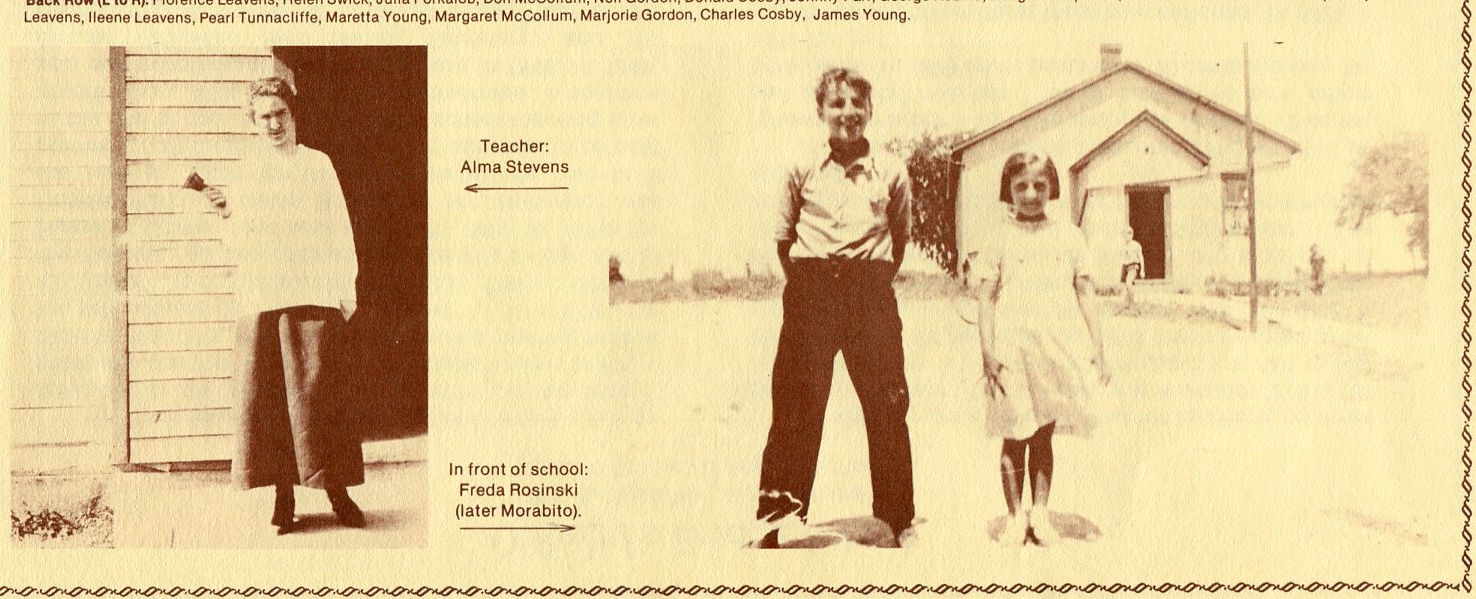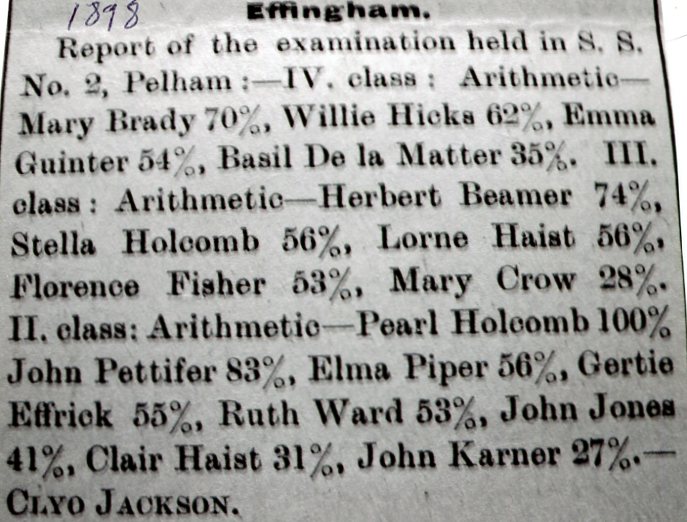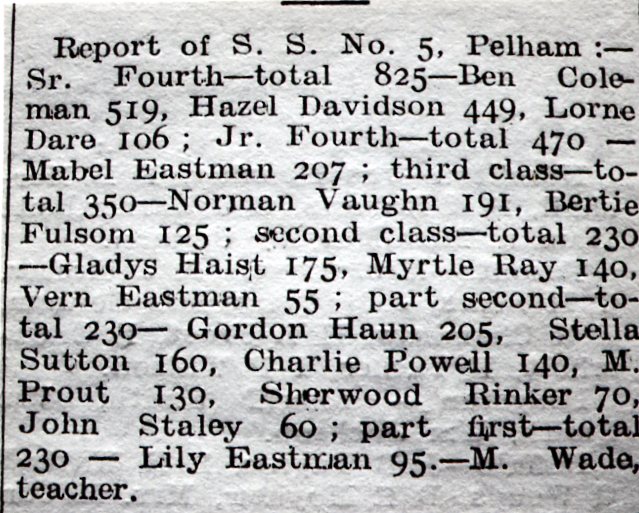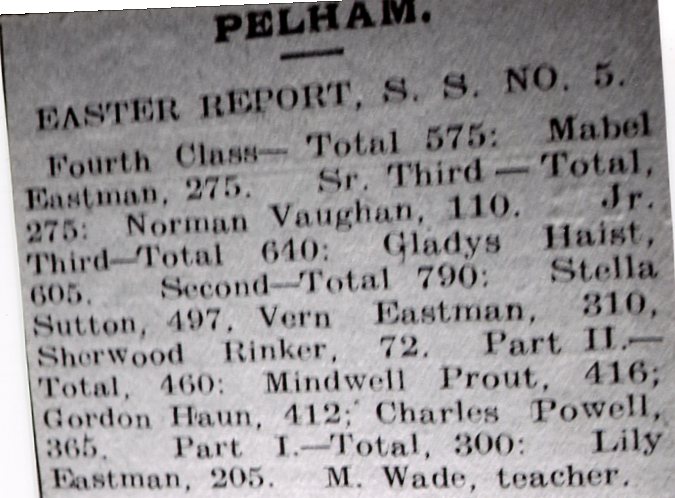[Author Unknown]
On the Hansler property, in 1821, was built the first school in this area of Pelham Township—a school which was to last until 1860.

The second school, a one-roomed brick building was in use from 1860-1958. Like many other schools at the time, the structure had a belfry and a bell. There was a porch on the front, separate entance for the boys and the girls, two washrooms and was heated by means of a stove which was situated right in the classroom. Fuel for this stove was stored in an outside woodshed. In addition to the desks, there was a piano in the classroom.

The third building constructed in 1958 was of white brick and had two classrooms, two washrooms, storage room, boiler room and an office.. Off each classroom was a cloakroom for the class.
The school has been closed and its windows boarded (1970). The schools were situated on the corner of Metler and Effingham Roads.
At first, the teachers were paid by those parents whose children were sent to school. Interest was shown as to whether to continue supporting the early schools in this manner or for the schools to be free of charge to the parents and rates levied on everyone’s property.
In those early days, the wood consumed by the heating system was supplied by the parents.
(Note- in 1821, the Becketts built the first school on the Hansler property,. Mr. De La Mater donated land for the school in 1860. This land was across the road from the original school. The school was always known as Hansler’s School.
[Author Unknown]
The land for the first school was donated by the Oille family and the building itself was constructed of logs. The second structure (brick) burned and was replaced by a third one (also brick) which too was destroyed by fire. When the second one burned, school was held in an old house in Sanderson’s orchard. On the third structure, a platform was constructed on the outside of the building. In all, there were four schools at this location.
There were no cloakrooms for hanging your outdoor clothing but coat hooks were placed around the room. The building was heated with gas and all eight grades were in the one room. The pupils sat in double desks and slates and slate pencils were the writing medium.
Electricity was installed in 1939, and a fence put across the front. Two trees were planted in the yard during the reign of George VI and the school received township and county honours for school beautification.
The teachers made their own timetables and the teacher taught all subjects to all grades. For punishment, the fingers were tapped with a pointer but there was the strap, although it was seldom used.
The methods of transportation were walking, horse and buggy and in the winter, horse and sleigh.
In 1945, a school area was formed uniting North Pelham (SS#7), Reece’s (SS#8), and Laws(SS#1) into Pelham area #1. Cupboards were built in the school and pencils, pens, etc. were supplied to the pupils. In 1948, indoor conveniences were added, the interior was painted and landscaping was done.
In 1949, Laws school housed grades one and two. It is interesting to note that during that year, an epidemic of measles closed the school. Also at that time after twenty years of service, “the old clock” stopped and was replaced with an electric one. In 1955-56, the school was once more repainted and some blackboard lights installed. Land purchased from Mr. J. Gilmore in 1956 made the yard larger.
The school was situated on the Pelham Stone Road. With the coming of County Boards, the school was closed.
Teachers
1885-88 Ed Michener—Tintern
1888-89 Frank Moffat—Rockway
1889-90 Robert Smith—St Catharines
1890-91 Miss Tushey
1891-92 Miss Leppert—Fenwick
1892-95 Julia Ferguson—Fenwick
1895(3Mos) Miss Chase—St Catharines
1895-96 Wilson Kline—Effingham
1896-97 John Trembley—Smithville
1904 Florence Carroll
1917-19 Laura Cavanagh
1922-30 Vera E. Morris—Effingham
1930-32 Marion Fox
1932-36 Margaret Van Every
1936-37 Ethawyn Damude
1937-39 Barbara McGee
1939-43 Margaret McFarlane
1943-44 Margaret Doherty
1945-48 Mrs. Vera Stewart
1948-49 Miss Flumerfelt—St Catharines
1949-51 Miss Betty Burley
1951-52 Miss Mary Wilkinson—Toronto
1952-54 Miss Enid Mason—St Catharines
1954-55 Miss Mary Moore—Turner’s Corners
1955-57 Mrs. Lois Tobias—North Pelham
[Author Unknown]
This school began in 1832 when Nicholas Ollie donated land to the west of his home for the purpose of building a school. Upon this land a log school house was erected, measuring 24 feet square. The second school, made of brick, was built to the east of the log school. This school was destroyed by fire early in the twentieth century, and was replaced by a third school in 1906. This school also suffered the ravages of fire, and had to be rebuilt in 1916. This building was located at 2052 Effingham Street.
Students wrote about their school in scrapbooks, giving the impression that it was spartan by modern standards. The equipment consisted partly of a dunce cap and a birch rod. Only the fourth and final school was decorated in warmer tones. Electricity was installed around 1939. The school yard was well landscaped, and earned awards in the Welland County Beautification Contest four times between 1926 and 1930. (See the History of Education in Ontario for more details of the Beautification contest)
In the early days, Law’s School accomodated scholars between the ages of 5 and 16. The average attendance between 1845 and 1857 was 44, with the highest enrollment being 50.
Several teachers were hired before one was listed as having “qualifications”. At times, teachers were hired for one or two months, and then dismissed. Wages were not high, as they depended on the contribution of money from local parents. On January 10, 1855, the teacher’s salary was raised a certain amount per “Schollar” (spelling intentional), and henceforth only those who sent children to school were to be taxed. In addition, each “Schollar” was to furnish one-quarter cord of good wood, which was to be measured by the teacher and a receipt issued.
[The following was composed by Mrs. A.M. Phillips and some of the board members of this school prior to its closing. Mrs. Phillips was at one time a teacher at this school.]
The first record to be found of the O’Reilly’s Bridge School is for the year 1847 but according to this record, there was a school in this district previous to that date, known as No. 6 Wainfleet and No. 5 Pelham.

The invitation to organize a Union section read thust:”A meeting is to be held in O’Reilly’s Bridge School house for the purpose of organizing a Union Section and electing three fit and proper trustees.” Those present at this meeting were: Robert McCormick, John B. O’Reilly, Peter Jennings, Robert Simcoe Chapman, Alex B. Chapman, Wm. Bunts, Charles Parks, Sayers Hagar. Trustees elected were: John O’Reilly, Sayers Hagar,, Charles Park, who was to be the Sec.-Treas.
The first teacher to be hired by the above board was Mr. Gavin Robertson for three months at the rate of 5 pounds 10 shillings per month.
The contract read: “We do hereby contract and employ Gavin Robertson at the rate of 5 pounds 10 shillings($240. Per year) and we further bind ourselves and our successors in office to faithfully employ the powers with which we are legally invested, by said section, and said act to collect and pay said teacher. Which sum is to be paid at the expiration of the term.”
The first school meeting after organization was held in Jan. 1847. The chairman was John Phillips. A common seal was adopted and was ready to use in 1848. In 1849, Simcoe Chapman was name secretary and his penmanship was worthy of note.
 The second teacher was Paul Marlott at 5 pounds 10 shillings per month but was to be paid quarterly. The third teacher was one Sarah Chapman at 42 pounds per annum and the fourth was Edward Henry at 5 pounds 10 shillings per month.
The second teacher was Paul Marlott at 5 pounds 10 shillings per month but was to be paid quarterly. The third teacher was one Sarah Chapman at 42 pounds per annum and the fourth was Edward Henry at 5 pounds 10 shillings per month.
In 1849, Peter Jennings became the new trustee and Sayers Hagar became the new Sec,-Treas. (More notable penmanship here.) In 1850, the following resolution was passed: “Moved by Mr. C. Park, seconded by A.B.Chapman that the school now in use in said section is in a very delapidated state and also very small; is not sufficient to make the children comfortable or in any way answer the demands of the section; it is therefore resolved that a new school house be built at O’Reilly’s Bridge as soon as possible—to raise funds 1 by public subscription 2 or by taxing all section owners alike. The discussion re what method to be used waxed rather warm apparently. Finally a combination method was adopted.
It was decided that said school was to be erected on a rise of land on the southmost part of Lot 7 of the Township of Pelham bordering on the Chippawa River Road. The trustees were to examine several other schoolhouses to decide how best to direct the building of the new schoolhouse.
In 1852, Wm. Phillips became a new trustee and John B. Henderson became the new secretary. At a meeting in 1852, it was moved by Mr. Chapman and seconded by Mr. O’Reilly that the old school be sold instantly and that proceeds were to go to 1 pay off debts 2 to pay for a new stove and pipe for the new school 3 balance if any to be applied to purchasing new apparatus deemed necessary for the new building.
Then and there Sayers Hagar became salesman for the old school. It was cried off to the highest bidder at 10 pounds 10 shillings to John B. O’Reilly.
During the year 1852-53, several school meetings were held in early candle light to determine whether it was to be 1 Free School 2 Direct Taxation. Three votes taken. The results were: 1. 3–11, 2, 4–11, 3. 15-15.
The chairman broke the tie in favour of direct taxation. Here a few pages are missing from the record but according to the financial report, the new school (the present one) must have been built in 1853. It is difficult to estimate the cost from records as much work was done gratis by members of the section-some bringing timber, some glass, some cement, etc.
Walter Henderson succeeded Edward Henry as teacher in 1853, followed by Bridget May Kelly in 1854. Walter H. Received 60 pounds, Bridge May 30 pounds, This gives a good contrast of male and female teacher’s salary. Bridge May asked for a raise of 5 pounds; this was refused; and apparently she left in 1855. J. Winters became the next schoolmaster at a salary of 90 pounds and 5 pounds for equipment.
In 1856, John Phillips became the new trustee and Archie Cumming was hired as teacher at 90 pounds per annum. To raise funds in those days they charged one third pound per child per month or approximately one dollar and fifty cents per month, the remainder being raised by voluntary subscriptions.
In 1856, it was difficult year for teachers, as three served in one year, namely-Robert Lamont, Azabah Hagar and Marjorie Rich.
During this year cordwood was purchased for $1.50 per cord.
In 1857, Andrew Martin became the new trustee and the schoolmaster was Chas Pennington. His contract read: “Chas. Pennington hired for $25 per month, said teacher contracts and binds himself to teach and conduct the school in said section—etc. And to be perfectly temperate during his engagement under pain of forfeiture of his wages, (Chas. Must have been as good as his word for a short time. Then was off-duty and re-hired for a period of two years. Mr. Pennington was another who was outstanding for his penmanship. He apparently became Secretary also for his term of office.
During 1860, Mr. Peter McCollum was elected as trustee. Mrs Henry Cram was school teacher at an annual wage of $264.
In 1861, Mr. Jas. Lawrence became schoolmaster and in 1862, Munroe Howland, each at $18 a month.
In 1863, the first auditors came and it also brought assessment by direct tax on property. But still each child was assessed 25 cents per month. And this was collected by the teacher and an account given to the board.
Miss Emma Gilchrest taught in 1869 at $192 per annum and her successor was Miss Hampton at $16 per month.
During 1873, a discussion took place re the removal of the school to another location but the motion was turned down flatly. In 1873, Miss Julie Price taught one month on approval-was found satisfactory and was engaged for the year at $240.
In 1874, the board of Trustees consisted of Andrew Melick, Geo. Eastman, Wm Phillips with S. Jennings as Sec. Treas. These served until 1877 when Mr. Melick was replaced by Mr. Clarke McCollum, Richard Farr and Jas, Armstrong became trustees in 1879 and served until 1885 when Mr. Poth and Mr. Misener were added to the Board.
In 1887, Mr. Van Wyck became trustee and Mr, Clarke McCollum the secretary. During the year 1889, Mr. Norman McClellan became the secretary and Mr, Weallens the new trustee.
An agreement of interest in 1889 read thus:” We hire Mr. Howard Kenned as teacher, He is to put on fires, sweep the school and teach for $300 per year..” The following year he got $5 for putting on the fires.
It is interesting to note that at this time $1 was paid to Leidens to clear grass and thistles from the school property, also $3 to Mrs. Robins to whitewash and scrub the classroom.
School requisitions were first sent to the council in 1887. The first globe was bought for the school the first year.
May 9, 1888-A trustee asked the Board to consider teaching Temperance and getting some chairs and a teacher’s desk. It was noted that one turned up for the next meeting, “No one came-only myself an hour and went home.” -Clarke McCollum. It was noted however, that the following year a teacher’s desk (The present one) was bought for fourteen dollars. And two chairs for two dollars a piece.
In 1890, the Sec.-Treas first received a salary of $5. The teacher this year was Mr. Thos. Phillips and Miss Kate Brown completed his second term at the rate of $300 yearly.
Miss Sara Gaiser (now Mrs. Hutton) taught for the years 1891- 1892. The first year she received $200.08 and second $241.14.
In 1893, Mr. Chas Haist became the treasurer. Facts from the Treasurer;s Report are as follows: 1847-2 brooms @20 cents each, box of chalk 12 cents; dipper 18 cents, making fires $1; pail 25 cents, marches 7 cents, stove pipe elbow 371/2 cents.
1894-Money changed from pounds and shillings to dollars and cents. Robert Murphy was hired as caretaker to build fires, sweep and dust and scrub twice yearly for $10.00.
1895- Many applications received for teacher. After much discussion as to qualifications and beauty, it was decided to hire Miss Mae Morin @250.00
1896- Mr. R. Overholt appointed trustee. Ratepayers asked to come and fill up old death trap of well in yard. Bring their teams.
1908—R. Phillips was Sec. At a salary of $10 in 1910, boosted to $12. for Mr. R. Overholt Messrs W. Sutton, and E, Snelling were the new trustees.
1912—Question of cistern discussed. Meanwhile Harland Overholt was to carry water for drinking purposes from Jam 1 to Apr 6 for $3.00 Later H. Overholt became caretaker for $30.00 per annum.
1913—J Murphy—trustee, A. Mansfield- Sec. Treas. New well dug and walks laid at the school. Wages ran thus: $4 per day for Mr. Burns, $2.25 for helpers; 40 cents per hr. For cement mixer; $1.70 per barrel for cement; 50 cents per hr. For a team. A turnstile was purchased which approximately 30 years later, still had one prong in existence.
1915—Trustee R. Niger and W. Cosby was Secretary
1920 –Chas. McCollum was trustee; 1922—A. Snelling was trustee.
1923—E. Damude—Chairman; Miss Stevens-Teacher; faithful trustee R. Overholt died.
1924—Mrs. Jennie Misener-teacher @100. per mo. Term completed by Miss Scott.
1927—Miss A. Arnold of Cambellford became teacher at a salary of $1000. per year.
Trustees—Messrs Thos Phillips, Richard L Leavens, Scott leidy
1928—Miss Helen Grenzebach taught for a short time.
1929—Flagpole erected. Trustees—Messrs N. Bartlett, Thos Phillips, J. Murphy and S. Leidy Sec-Treas, at a salary of $25. Mr. Leavens donated a medicine chest, O’Reilly’s Bridge Womens’ Institute provided First Aid supplies. Mr. Leavens also made and donated two long wooden benches for school use.
1933—Miss H. Jean Lane became teacher. Hydro was installed. R. Phillips-sec.
1934– A piano was added to the school equipment. The well was repaired.
During these years, Mrs. J. Cosby and family served as caretakers.
1935—Caretakers Mr. Elliott Robins and Mr. Ila Michener.
1937—New hardwood floors were laid at a cost of $105, plus labor. A new electric clock was purchased and a set of Books of Knowledge were added to the school equipment.
1938-39—Music was first taught officially in school by Miss E. Robertson.
1952-53—The school was closed and sold for approximately $4000.00
It was converted into a home and now has a value of about five times its purchase price.
Believe this may have been from the file of George “Udy”Blazetith
DOWN MEMORY LANE
[Welland Tribune, Date Unknown]
 If you think your telephone directory is becoming somewhat cumbersome, of if you’re having trouble ripping it in half, consider the 1885 edition.
If you think your telephone directory is becoming somewhat cumbersome, of if you’re having trouble ripping it in half, consider the 1885 edition.
Welland’s first telephone directory, issued about 29 years after the county of Welland was established, listed a grand total 25 names. The Bell Telephone exchange, then located at C.J. Page’s grocery store, was open for business 12 hours a day on weekdays, 4 hours on special holidays, and 2 hours on the Sabbath. The mini-telephone book, dated December 1885, listed the following names and information as follows:
Beatty and Sons, Main St.
Beatty and Sons, Foundry, Main St.
Burgar, Dr., Office, Main St.
Burgar, J.H. Druggist, Main St.
Court House, (Sheriff’s Office) Main St.
Dexter House, E. Hoover, Prop., Main St.
Duncan, C.J., (Sheriff) Residence, Main St.
Fraser, House, F. Tuckett, Prop., Main St.
Garner, L.V., Auctioneer, Residence, Main St.
Great North-Western Telegraph Co., Main St.
Gross, J.F., Pump Manufacturer, Main St.
Harcourt and Cowper, Barristers, Main St.
Hill, J.F., Ins. Agt., Residence, Aqueduct St.
Hobson Bros., Druggists and Div. Court Office, Main St.
Imperial Bank, Muir St.
Michigan Central Railway Station, Muir St.
Page, C.J., Merchant, Main St.
Page, J.C., Dep. Registrar, Residence, Division St.
Registry Office, Main St.
Sullivan, J., (Government Contractor), Residence, Main St.
Telegraph Printing Office, Main St.
Tufts, D., Omnibus Line, Division St.
Welland House, P.W. Raymer, Prop., Main St.
Welland Station, Main St.
Williams, A. Barrister, Main St.
In the accompanying photograph, taken in 1909, a telephone line crew provided an unusual sight in those days. The modification of the skyline was one of the first steps in providing the incredible technological changes in communications of the future.




 Subscribe..
Subscribe..








 If you think your telephone directory is becoming somewhat cumbersome, of if you’re having trouble ripping it in half, consider the 1885 edition.
If you think your telephone directory is becoming somewhat cumbersome, of if you’re having trouble ripping it in half, consider the 1885 edition.